Published by Robert Hale in 1975, 205 pages. It's currently available from Amazon UK for the princely sum of 1p!
Most unusually for an Edward II novel, The She-Wolf opens in 1325, shortly before Edward sends Isabella to France to negotiate with her brother Charles IV over the Gascon situation. It closes just after Edward III's successful coup against his mother and Roger Mortimer in late 1330.
Pamela Bennetts has an excellent understanding of the politics and general comings and goings of Edward II's reign, although sometimes she uses infodumps in the narrative to get the point across. Also, the late opening of the novel requires a lot of flashbacks in the first chapter to see Piers Gaveston, and the fact that falling in love with men is a pattern of Edward's behaviour. However, these are minor criticisms; the dialogue and characterisation are uniformly excellent.
I've never read another Edward II novel where Queen Isabella is so unsympathetic - the title is highly appropriate! Much of The She-Wolf is seen through the eyes of Isabella's attendants, who slowly come to realise that the sweet, suffering woman they adore is in fact - not to put too fine a point on it - a complete bitch, calculating, manipulative and so full of anger and hatred that she's almost abnormal. Even Roger Mortimer, who's also described as almost insane with ambition and bitterness, is frightened at what he unleashes. Isabella watches the execution of the younger Despenser and regrets that he doesn't last longer and suffer more. She is completely indifferent to her husband's murder, and the execution of her brother-in-law Kent. And yet, the reader can't help but feel sorry for her, at least in the earlier part of the novel. She genuinely yearned for Edward when they first married, and felt unclean at the thought of his relationship with Gaveston. Her frustrated love is warped and twisted until she feels nothing but hatred and contempt for her husband, and her relationship with Mortimer has nothing sweet or tender about it - it's based on lust and control.
Mortimer and Isabella are masters of propaganda here - even Isabella's reunion with her younger children in Bristol in October 1326 is stage-managed in front of a crowd to increase their sympathy for a woman deprived of her children by her heartless husband, and Mortimer only pretends to care that his wife and own children have been imprisoned, because it gives him a stronger reason to take revenge on the king and Despenser. Even Mortimer doesn't trust Isabella completely.
Edward II himself is reasonably sympathetic. At the start of the novel, he and Isabella utterly detest one another - they speak honeyed words to each other in public, while wanting to spit at and slap each other. It's a lovely portrayal of a marriage that's gone as wrong as a marriage possibly could. Although Isabella chooses to believe otherwise, and spreads vicious rumours about them, he and Hugh Despenser are not lovers here. Edward loves Despenser, but only because Despenser supports him and takes on the burden of ruling, which Edward doesn't want.
Edward III, after his father's murder - by the usual method - realises that the only way he will survive and overcome Mortimer is to bide his time, and copy his mother in hiding his true feelings and his true nature, and pretending to be meek and biddable.
In conclusion, this short novel is well worth a read, with excellent characterisation and genuine suspense near the end, as the reader wonders whether Edward III will be successful in his coup against Isabella and Mortimer - even while knowing that, historically, he was. But it's definitely not a novel for anyone who believes the recently popular 'Isabella has been unfairly maligned by history' theory!
Welcome to the site which examines the events, issues and personalities of Edward II's reign, 1307-1327.
29 October, 2006
21 October, 2006
Novels, names and Nottingham (and a tomb)

This is the tomb of Hugh le Despenser the younger, buried in Tewkesbury Abbey in late 1330 or early 1331, after the five parts of his body had been on public display around England for four years. The tomb was much mutilated in the sixteenth century, and used to contain forty statues. The coffin actually belongs to Abbot John Cotes, who died in 1347 - and who was probably the man who presided over Hugh's funeral. For some reason, his coffin was placed in the tomb in the seventeenth century. Despenser's remains are presumably underneath.
Barbara Green of the Yorkshire Robin Hood Society has left a long and fascinating comment on an old post, here. Many thanks for that, Barbara! She points out that, contrary to popular belief, the real Robin Hood most likely did not live in Richard I's reign, but in Edward II's. This has inspired me to follow up her references and read more about this. (Anyone watching the BBC's Robin Hood, by the way? I caught the first one during my holiday. One episode was more than enough, I think.)
Remember the romance novel Infamous, that I reviewed a while back? The sequel Notorious is due out next May, starring Jory de Warenne's daughter Brianna. According to this message board, the hero is Roger Mortimer's son....Wolf.
Words fail me.
A novel far superior to this one, I'm sure, is currently being written - one that takes place in 1330 and has the hero playing a role in Edward III's coup against Isabella and Roger Mortimer (yes, the one who fathered a son named Wolf. Allegedly.) I don't know the identity of the author, but you can see an extract of her work in progress here. She was also kind enough to leave some comments on the post below this one. Isabella, according to the author, is very much the 'She-Wolf' here - in my view, a welcome antidote to the fawning dissertations, biographies and novels featuring Isabella that are currently fashionable.
And finally, on the subject of Edward III's 1330 coup, Susan Higginbotham has written an excellent post on the subject. The 676th anniversary fell a couple of days ago (assuming my maths is correct; it's been a long week). Susan draws attention to Isabella and Mortimer's foolish behaviour during their regency. They'd invaded England supposedly to liberate the people from the tyranny of the Despenser regime, but proved themselves to be even greedier and less able to command the loyalty of their followers - something all too often conveniently ignored in recent works on Isabella.
15 October, 2006
Photos
A detail of Hugh the younger Despenser's tomb at Tewkesbury Abbey, showing some of the statues that were mutilated in the sixteenth century - his tomb was magnificent before that (for some reason Blogger won't let me upload the photo of it, so I'll save it for another post):
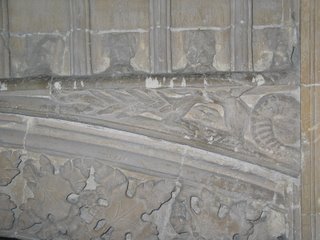
The Three Kings pub in Hanley Castle, Worcestershire:

The church at Hanley Castle:

The 'Kneeling Knight' of Tewkesbury - Edward, Lord Despenser (1336-1375), grandson of Hugh the Younger and grandfather of Isabelle, below. His son Thomas was created earl of Gloucester in 1397 and beheaded in 1400, trying to put Richard II back on the throne. Edward was described by the chronicler Jean Froissart as the most handsome, the most courteous and the most honourable knight in England' (qualities he probably didn't inherit from his notorious grandfather ;)
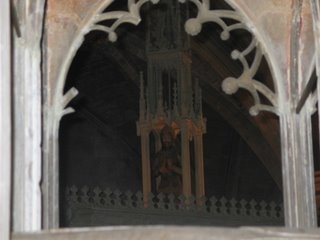
The Despenser/Beauchamp chantry at Tewkesbury - paid for by Isabelle Despenser (1400-1439), great-great-granddaughter of Hugh the Younger and grandmother of Richard III's queen, Anne Neville. Isabelle had two husbands, both called Richard Beauchamp. ;) I love this photo because you can still see the colours of the chantry.
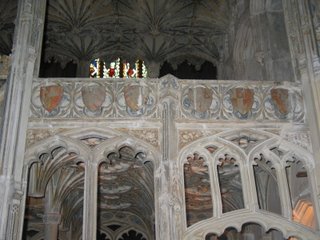
And for no other reason except that she's terribly cute, here's my mum's dog, Tara. ;)


The Three Kings pub in Hanley Castle, Worcestershire:

The church at Hanley Castle:

The 'Kneeling Knight' of Tewkesbury - Edward, Lord Despenser (1336-1375), grandson of Hugh the Younger and grandfather of Isabelle, below. His son Thomas was created earl of Gloucester in 1397 and beheaded in 1400, trying to put Richard II back on the throne. Edward was described by the chronicler Jean Froissart as the most handsome, the most courteous and the most honourable knight in England' (qualities he probably didn't inherit from his notorious grandfather ;)

The Despenser/Beauchamp chantry at Tewkesbury - paid for by Isabelle Despenser (1400-1439), great-great-granddaughter of Hugh the Younger and grandmother of Richard III's queen, Anne Neville. Isabelle had two husbands, both called Richard Beauchamp. ;) I love this photo because you can still see the colours of the chantry.

And for no other reason except that she's terribly cute, here's my mum's dog, Tara. ;)

More photos
The site of Hanley Castle, Worcestershire - built by King John in the early 1200s, passed to the de Clares and then to the Despensers, derelict by the sixteenth century:

Windows in the choir of Tewkesbury Abbey, paid for by Eleanor de Clare:

Deerhurst church (founded before 804):
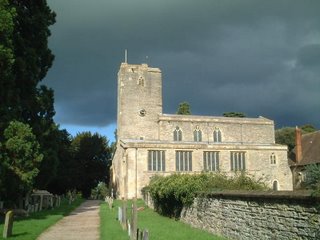
Odda's Chapel (consecrated 1056):
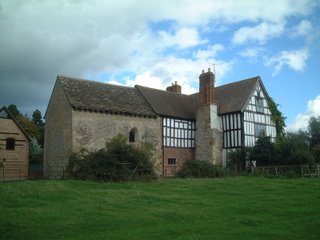
Hailes Abbey (founded 1246):
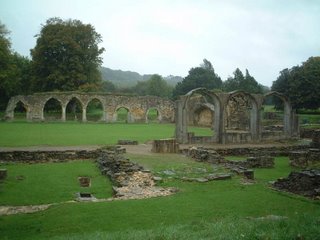
Sudeley Castle, from the back seat of the car:

Berkeley Castle:

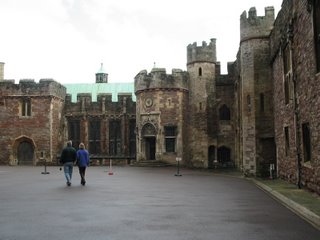
EDIT: Blogger, or my PC, is having a snit - I'll post the remaining photos later, or tomorrow.

Windows in the choir of Tewkesbury Abbey, paid for by Eleanor de Clare:

Deerhurst church (founded before 804):

Odda's Chapel (consecrated 1056):

Hailes Abbey (founded 1246):

Sudeley Castle, from the back seat of the car:

Berkeley Castle:


EDIT: Blogger, or my PC, is having a snit - I'll post the remaining photos later, or tomorrow.
13 October, 2006
My Edward II Pilgrimage

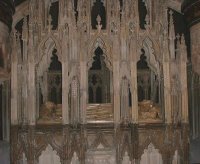
I had a great time in Gloucestershire, visiting sites associated with Edward II. The thing I most wanted to see was Edward II's tomb, in Gloucester Cathedral - a magnificent canopied shrine described by the Cathedral as 'one of the great monuments of England'. The shrine is currently covered in scaffolding, as it's being restored, at a cost of £70,000, apparently. The Cathedral is planning a 'series of events to commemorate Edward II' in 2007 and 2008.
I found it really moving to be so close to Edward - I stood there for ages, until one of the men working on the tomb started giving me funny looks. The day before, we'd visited Berkeley Castle, where Edward was imprisoned in 1327 (and freed by some of his supporters - see the comments on this post). I'm afraid to say I found Berkeley rather disappointing, at least from an Edward point of view. Much of the castle is closed to visitors, and the guided tour barely mentions Edward and focuses instead on the later Berkeleys. You can see the cell where Edward was held, but not enter it - you can only peer through a rather narrow window. I was hoping to get some idea of how the Dunheveds might have entered the castle in 1327 and freed Edward, but unfortunately I couldn't picture it at all. Still, Berkeley is well worth a visit (it's closed till next April, however) for anyone interested in later periods of history. I did enjoy seeing the Great Hall, which was rebuilt by Thomas Berkeley, Edward's jailor, around 1340.
In the photo (left, above) Edward's cell is above the doorway on the right.
We also visited Tewkesbury Abbey, a superb building consecrated in 1121, bigger than fourteen English cathedrals, which was saved during the Dissolution when the townspeople bought it for £453. The Abbey is practically the mausoleum of the Despenser family - the notorious Hugh the Younger was buried here in late 1330, in five pieces, after Edward III finally gave permission for his rotting remains to be removed from London Bridge, York, Carlisle, Bristol and Dover four years after his execution. His wife Eleanor de Clare is here (burial place unfortunately unknown) as are numerous descendants of theirs.
Another site associated with the Despensers is Hanley Castle, in Worcestershire. Sadly there's absolutely nothing left of the castle itself - except the flat hill where it once existed - but Hanley Castle, the village, is very pretty with a lovely old church and a school founded in 1326. Edward II and Queen Isabella were guests of Hugh Despenser here in January 1324, and Eleanor de Clare was abducted from Hanley by her second husband, William la Zouche, in early 1329.
We also took the opportunity to visit other historical sites in Gloucestershire and Worcestershire. Evesham is the site of a battle of 1265, where Edward II's father defeated Simon de Montfort, earl of Leicester - his uncle by marriage. Roger Mortimer - grandfather of Edward II's Roger Mortimer - sent de Montfort's head to his wife as a present! Worcester Cathedral contains the tomb of Edward II's great-grandfather King John (died 1216) as well as the chantry of Prince Arthur, elder brother of Henry VIII. The village of Deerhurst, a mile or so from where we were staying, contains two pre-Conquest buildings, astonishingly enough: Odda's Chapel, of 1056, and the Church of St Mary, which dates back to before 804. We didn't go in, but saw Sudeley Castle, former home of Henry VIII's last wife Katherine Parr, and spent a morning in the driving rain looking around Hailes Abbey - founded in 1246 by Henry III's brother Richard of Cornwall. Hailes was a very important place of pilgrimage in the Middle Ages.
All in all, I had a great holiday in a lovely, really interesting part of England!
26 September, 2006
Blog Hiatus, and Queen of Shadows
I'm off on my holidays for a couple of weeks - we're staying with my mum in the Lake District for a few days, then driving down to Gloucestershire on my 'Edward II Pilgrimage'! My next post will be on 11 October, or thereabouts.
If you haven't read the comments on the last post, please do so - Carla and I had a fascinating discussion going on. When I get back, I'll write some more posts on the theory that Edward II wasn't murdered at all, and on his escape from Berkeley Castle in the summer of 1327.
Before I go, here's a review of Edith Felber's Queen of Shadows, released 7 November, from Amazon.com:
***
Isabella, the French princess at the center of Felber's deftly plotted historical, matures from a 12-year-old bride of Edward II of England to a clever conspirator driven by a thirst for power. Not so secretly gay and viewed as weak, Edward is ordered by Parliament to share his throne with the Earl of Winchester, whose son, Hugh, attracts Edward's attention. Isabella chafes at having to share the throne, particularly with Hugh, who proves to be a rapacious presence. One of Isabella's ladies-in-waiting, Gwenith of the Marches, secretly plans revenge against Edward for his killing of her family, but her dedication to Isabella complicates her mission. After being introduced by Gwenith, Isabella takes condemned nobleman Roger Mortimer, imprisoned in London Tower, as a lover and with him plots a coup that unseats Edward and positions Isabella's son Edward as king. But Roger is shiftier than he initially appears, and allegiances, as ever, are up for grabs. The book is filled with strong-willed characters, though Edward's homosexuality is clumsily handled. Felber, who has written many historical romances as Edith Layton, delivers what fans of the genre want.
***
A big, resounding 'hmmmm....'. The bit about Edward being ordered by Parliament to share his throne with Winchester (Hugh Despenser the Elder) is complete nonsense, and the bit about Isabella and Roger Mortimer being introduced by Gwenith makes me giggle ("Your grace, this is Lord Mortimer, whom you've been seeing around court for the last few years. Lord Mortimer, this is the queen of England." Mortimer: "Seriously??") Not sure about the 'clumsily handled homosexuality' either. I hope Felber hasn't made Edward into a flaming queen, or there may be a book/wall interface. And 'London Tower'?? I hope that's Publishers Weekly's error, not Felber's.
Still, I'm looking forward to it, although I have a feeling I'm not going to like it very much...but only time will tell.
If you haven't read the comments on the last post, please do so - Carla and I had a fascinating discussion going on. When I get back, I'll write some more posts on the theory that Edward II wasn't murdered at all, and on his escape from Berkeley Castle in the summer of 1327.
Before I go, here's a review of Edith Felber's Queen of Shadows, released 7 November, from Amazon.com:
***
Isabella, the French princess at the center of Felber's deftly plotted historical, matures from a 12-year-old bride of Edward II of England to a clever conspirator driven by a thirst for power. Not so secretly gay and viewed as weak, Edward is ordered by Parliament to share his throne with the Earl of Winchester, whose son, Hugh, attracts Edward's attention. Isabella chafes at having to share the throne, particularly with Hugh, who proves to be a rapacious presence. One of Isabella's ladies-in-waiting, Gwenith of the Marches, secretly plans revenge against Edward for his killing of her family, but her dedication to Isabella complicates her mission. After being introduced by Gwenith, Isabella takes condemned nobleman Roger Mortimer, imprisoned in London Tower, as a lover and with him plots a coup that unseats Edward and positions Isabella's son Edward as king. But Roger is shiftier than he initially appears, and allegiances, as ever, are up for grabs. The book is filled with strong-willed characters, though Edward's homosexuality is clumsily handled. Felber, who has written many historical romances as Edith Layton, delivers what fans of the genre want.
***
A big, resounding 'hmmmm....'. The bit about Edward being ordered by Parliament to share his throne with Winchester (Hugh Despenser the Elder) is complete nonsense, and the bit about Isabella and Roger Mortimer being introduced by Gwenith makes me giggle ("Your grace, this is Lord Mortimer, whom you've been seeing around court for the last few years. Lord Mortimer, this is the queen of England." Mortimer: "Seriously??") Not sure about the 'clumsily handled homosexuality' either. I hope Felber hasn't made Edward into a flaming queen, or there may be a book/wall interface. And 'London Tower'?? I hope that's Publishers Weekly's error, not Felber's.
Still, I'm looking forward to it, although I have a feeling I'm not going to like it very much...but only time will tell.
21 September, 2006
Edward II's Death (?)
Today marks the 679th anniversary of Edward II's death...allegedly. I suppose most people know, or think they know, the story of Edward's terrible death - the 'red-hot poker' narrative that's passed into legend.
After Edward II's forced abdication in January 1327, he was first 'imprisoned' at Kenilworth Castle, under the care of his cousin Henry of Lancaster, who treated him with respect and honour. In April, he was transferred to Berkeley Castle, Gloucestershire, where his jailor was Thomas, Lord Berkeley - the son-in-law of Roger Mortimer. Berkeley had been imprisoned for several years by Edward, and his father had died during his own imprisonment, so he had little reason to like the king.
The chronicle of Geoffrey le Baker, written about thirty years later, mentions Edward's ill-treatment. He was held in a cell above the rotting corpses of animals, in an attempt to kill him indirectly. But Edward was extremely strong, fit and healthy, and survived the treatment, until on the night of 21 September 1327, he was held down and a red-hot poker pushed into his anus through a drenching-horn. His screams could be heard for miles around.
This has become the standard narrative of Edward's death, but there are problems with taking it at face value. Baker hated Queen Isabella (the 'iron virago') and was constructing a narrative of 'Edward as martyr'. The chronicles written shortly after Edward's death (Anonimalle Chronicle, a shorter continuation of the Brut, Lichfield Chronicle, Adam Murimith) variously state only that he died (with no explanation given), that he died of a 'grief-induced illness', or that he was strangled or suffocated. The official pronouncement of Edward's death, in September 1327, claimed that he died of 'natural causes'. It wasn't described as murder until November 1330, when Roger Mortimer was accused of 'having [Edward] murdered at Berkeley' during his show trial.
The earliest reference to the 'red-hot poker' method is found in a longer continuation of the Brut, written in the 1330s. However, many other fourteenth-century chronicles do not repeat this allegation. None of the men who killed Edward - for the purposes of this post, I'm assuming that he really was murdered in 1327 - ever spoke about it publicly. Therefore, we're dealing with rumour and hearsay, how the chroniclers thought he'd been murdered.
Admittedly, I find it very hard to view Edward's death objectively - I'm very fond of him, and would rather believe that he didn't die in such a vile way. However, the red-hot poker story does seem implausible. The idea was to kill him in such a fashion that no marks of violence would be visible on his body. However, why then kill him in such an agonising fashion that his screams could be heard for miles around? Why torture him, so that his (dead) face wore an expression of agony, if you were trying to pretend that his death was natural? Surely strangling or smothering, or even poison, would have been more effective. These methods would also have left physical traces on Edward's body, but if his eyes were closed and his body covered up, they would have been missed by the people viewing his body.
Here are some other ideas on the story:
- Mary Saaler, in her 1997 biography of Edward II, quotes Adam Murimith's comment that Edward was killed per cautelam, by a trick, and wonders if this phrase became corrupted to per cauterium, a branding-iron.
- Pierre Chaplais and Ian Mortimer have commented on the death of King Edmund Ironside in 1016, said to have been murdered in a similar way to Edward, while sitting on the privy. The story was often repeated in thirteeth-century chronicles.
- And finally, Edward's brother-in-law the earl of Hereford was killed at the Battle of Boroughbridge in 1322 when he was skewered through the anus by a spear pushed up through the bridge.
It's my belief that the grotesque 'anal rape' narrative of Edward's death (Dr Ian Mortimer's phrase) is nothing more than a reflection of the popular belief that Edward was the passive partner in sexual acts with men, and that this means of death represented Edward receiving his 'just desserts'. The deaths of the earl of Hereford and Edmund Ironside may have provided the inspiration for this.
Similarly, the castration (or emasculation) of Edward's favourite, the younger Despenser, in November 1326, was said by the chronicler Jean Froissart to be a punishment for his sexual relations with Edward. Whether this is true or not is impossible to say, but I think the narratives of both men's deaths reflect the widespread belief that they had sexual relations and were punished for them. Often, a story that begins as a joke or a rumour takes on the aura of 'truth' - such as the death of Edward's descendant George, Duke of Clarence, who died in the Tower of London in 1478. He is supposed to have drowned in a 'butt of malmsey'. It's difficult to ascertain whether this is the truth, or merely reflects his reputation as a drunkard.
Perhaps the story also represents a general human willingness to believe the most gruesome story - after all, being murdered with a red-hot piece of metal in the anus is far more 'interesting' than being smothered. And perhaps we shouldn't discount the early account of Edward's death from 'grief-induced illness', the accusation against Mortimer notwithstanding. At first sight it's not very plausible, but it is possible - given that Edward had lost his throne, his friends were dead, his family had turned against him, and he never saw his children again. If Edward was murdered in 1327, I'm far more inclined to believe that he was suffocated or strangled. He was a strong man and would have resisted, but of course he could have been murdered while he was asleep, or drugged.
But a far more fascinating question is - was Edward really murdered in 1327? Some modern historians incline to the view that he wasn't - which will be the subject of a further post shortly!
Until then, I'm going to raise a glass to King Edward II, who may or may not have died exactly 679 years ago. Cheers, Your Grace!
After Edward II's forced abdication in January 1327, he was first 'imprisoned' at Kenilworth Castle, under the care of his cousin Henry of Lancaster, who treated him with respect and honour. In April, he was transferred to Berkeley Castle, Gloucestershire, where his jailor was Thomas, Lord Berkeley - the son-in-law of Roger Mortimer. Berkeley had been imprisoned for several years by Edward, and his father had died during his own imprisonment, so he had little reason to like the king.
The chronicle of Geoffrey le Baker, written about thirty years later, mentions Edward's ill-treatment. He was held in a cell above the rotting corpses of animals, in an attempt to kill him indirectly. But Edward was extremely strong, fit and healthy, and survived the treatment, until on the night of 21 September 1327, he was held down and a red-hot poker pushed into his anus through a drenching-horn. His screams could be heard for miles around.
This has become the standard narrative of Edward's death, but there are problems with taking it at face value. Baker hated Queen Isabella (the 'iron virago') and was constructing a narrative of 'Edward as martyr'. The chronicles written shortly after Edward's death (Anonimalle Chronicle, a shorter continuation of the Brut, Lichfield Chronicle, Adam Murimith) variously state only that he died (with no explanation given), that he died of a 'grief-induced illness', or that he was strangled or suffocated. The official pronouncement of Edward's death, in September 1327, claimed that he died of 'natural causes'. It wasn't described as murder until November 1330, when Roger Mortimer was accused of 'having [Edward] murdered at Berkeley' during his show trial.
The earliest reference to the 'red-hot poker' method is found in a longer continuation of the Brut, written in the 1330s. However, many other fourteenth-century chronicles do not repeat this allegation. None of the men who killed Edward - for the purposes of this post, I'm assuming that he really was murdered in 1327 - ever spoke about it publicly. Therefore, we're dealing with rumour and hearsay, how the chroniclers thought he'd been murdered.
Admittedly, I find it very hard to view Edward's death objectively - I'm very fond of him, and would rather believe that he didn't die in such a vile way. However, the red-hot poker story does seem implausible. The idea was to kill him in such a fashion that no marks of violence would be visible on his body. However, why then kill him in such an agonising fashion that his screams could be heard for miles around? Why torture him, so that his (dead) face wore an expression of agony, if you were trying to pretend that his death was natural? Surely strangling or smothering, or even poison, would have been more effective. These methods would also have left physical traces on Edward's body, but if his eyes were closed and his body covered up, they would have been missed by the people viewing his body.
Here are some other ideas on the story:
- Mary Saaler, in her 1997 biography of Edward II, quotes Adam Murimith's comment that Edward was killed per cautelam, by a trick, and wonders if this phrase became corrupted to per cauterium, a branding-iron.
- Pierre Chaplais and Ian Mortimer have commented on the death of King Edmund Ironside in 1016, said to have been murdered in a similar way to Edward, while sitting on the privy. The story was often repeated in thirteeth-century chronicles.
- And finally, Edward's brother-in-law the earl of Hereford was killed at the Battle of Boroughbridge in 1322 when he was skewered through the anus by a spear pushed up through the bridge.
It's my belief that the grotesque 'anal rape' narrative of Edward's death (Dr Ian Mortimer's phrase) is nothing more than a reflection of the popular belief that Edward was the passive partner in sexual acts with men, and that this means of death represented Edward receiving his 'just desserts'. The deaths of the earl of Hereford and Edmund Ironside may have provided the inspiration for this.
Similarly, the castration (or emasculation) of Edward's favourite, the younger Despenser, in November 1326, was said by the chronicler Jean Froissart to be a punishment for his sexual relations with Edward. Whether this is true or not is impossible to say, but I think the narratives of both men's deaths reflect the widespread belief that they had sexual relations and were punished for them. Often, a story that begins as a joke or a rumour takes on the aura of 'truth' - such as the death of Edward's descendant George, Duke of Clarence, who died in the Tower of London in 1478. He is supposed to have drowned in a 'butt of malmsey'. It's difficult to ascertain whether this is the truth, or merely reflects his reputation as a drunkard.
Perhaps the story also represents a general human willingness to believe the most gruesome story - after all, being murdered with a red-hot piece of metal in the anus is far more 'interesting' than being smothered. And perhaps we shouldn't discount the early account of Edward's death from 'grief-induced illness', the accusation against Mortimer notwithstanding. At first sight it's not very plausible, but it is possible - given that Edward had lost his throne, his friends were dead, his family had turned against him, and he never saw his children again. If Edward was murdered in 1327, I'm far more inclined to believe that he was suffocated or strangled. He was a strong man and would have resisted, but of course he could have been murdered while he was asleep, or drugged.
But a far more fascinating question is - was Edward really murdered in 1327? Some modern historians incline to the view that he wasn't - which will be the subject of a further post shortly!
Until then, I'm going to raise a glass to King Edward II, who may or may not have died exactly 679 years ago. Cheers, Your Grace!
15 September, 2006
One Letter Makes All The Difference
From Sarah and Susan: a meme where you change just one letter in a novel title, and describe the new plot. Here are mine, featuring novels set in Edward II's reign (or thereabouts).
Lard of Misrule: Piers Gaveston's problems with overeating and the fury it engenders in Edward II's barons. (Lord of Misrule, Eve Trevaskis)
King's Wade: Bored with rowing and swimming, Edward II constructs a new water feature at his favourite manor of Langley. (King's Wake, Eve Travaskis)
The Traitor's Wire: Hugh Despenser becomes a successful pirate with the aid of a length of cable, and wonders how it could help him improve his extortion skills. (The Traitor's Wife, Susan Higginbotham)
Harlow Queen: The famous actress learns that she was Queen Isabella in a previous life. (Harlot Queen, Hilda Lewis)
The Tournament of Brood: The women of Edward II's court take part in an unusual competition to see who is the most desperate for a baby. (The Tournament of Blood, Michael Jecks)
Isabel the Pair: Isabel(la) is shocked to learn that she has an identical twin sister with the same name. (Isabel the Fair, Margaret Campbell Barnes)
The Love Knit: Isabella gets out her needles to make Roger Mortimer warm cardigans and mittens, in order to prove her love for him. (The Love Knot, Vanessa Alexander)
The Dollies of the King: Edward II tries desperately to keep his large collection of dolls a secret. (The Follies of the King, Jean Plaidy)
The Zion of Mortimer: After escaping from the Tower, Roger travels to Jerusalem to drum up support for his anti-Edward platform. (The Lion of Mortimer, Juliet Dymoke)
The She-Golf of France: Fed-up with unisex sports, Isabella returns to France to play her favourite game on a women-only course. (The She-Wolf of France, Maurice Druon)
Death of a Ming: During a row with Edward, a furious Isabella throws a vase at him. (Death of a King, Paul Doherty)
The Bows of the Peacock: Edward tries to teach a bird how to genuflect before his royal majesty. (The Vows of the Peacock, Alice Walworth Graham)
The King is a Ditch: Edward II takes one of his favourite hobbies very seriously indeed. (The King is a Witch, Evelyn Eaton)
Hummer of the Scots: Edward I invades Scotland with the aim of providing all the inhabitants with an SUV. (Hammer of the Scots, Jean Plaidy)
Lard of Misrule: Piers Gaveston's problems with overeating and the fury it engenders in Edward II's barons. (Lord of Misrule, Eve Trevaskis)
King's Wade: Bored with rowing and swimming, Edward II constructs a new water feature at his favourite manor of Langley. (King's Wake, Eve Travaskis)
The Traitor's Wire: Hugh Despenser becomes a successful pirate with the aid of a length of cable, and wonders how it could help him improve his extortion skills. (The Traitor's Wife, Susan Higginbotham)
Harlow Queen: The famous actress learns that she was Queen Isabella in a previous life. (Harlot Queen, Hilda Lewis)
The Tournament of Brood: The women of Edward II's court take part in an unusual competition to see who is the most desperate for a baby. (The Tournament of Blood, Michael Jecks)
Isabel the Pair: Isabel(la) is shocked to learn that she has an identical twin sister with the same name. (Isabel the Fair, Margaret Campbell Barnes)
The Love Knit: Isabella gets out her needles to make Roger Mortimer warm cardigans and mittens, in order to prove her love for him. (The Love Knot, Vanessa Alexander)
The Dollies of the King: Edward II tries desperately to keep his large collection of dolls a secret. (The Follies of the King, Jean Plaidy)
The Zion of Mortimer: After escaping from the Tower, Roger travels to Jerusalem to drum up support for his anti-Edward platform. (The Lion of Mortimer, Juliet Dymoke)
The She-Golf of France: Fed-up with unisex sports, Isabella returns to France to play her favourite game on a women-only course. (The She-Wolf of France, Maurice Druon)
Death of a Ming: During a row with Edward, a furious Isabella throws a vase at him. (Death of a King, Paul Doherty)
The Bows of the Peacock: Edward tries to teach a bird how to genuflect before his royal majesty. (The Vows of the Peacock, Alice Walworth Graham)
The King is a Ditch: Edward II takes one of his favourite hobbies very seriously indeed. (The King is a Witch, Evelyn Eaton)
Hummer of the Scots: Edward I invades Scotland with the aim of providing all the inhabitants with an SUV. (Hammer of the Scots, Jean Plaidy)
09 September, 2006
Edward II's Maternal Family
Edward II's mother was Eleanor of Castile, probably born in 1241. On 1 November 1254, she married the future Edward I (born 1239), elder son of Henry III, in Burgos; their marriage was intended to prevent her half-brother Alfonso X from claiming Gascony, which was ruled by England at that time. Eleanor bore fifteen or sixteen children, but only six of them outlived her (see here and here for my previous posts on her children).
Eleanor's mother was Jeanne de Dammartin, born circa 1216/20, Countess of Ponthieu and Montreuil in her own right. Jeanne had once been betrothed to Henry III, but he broke off the engagement in order to marry Eleanor of Provence. She married Fernando III, king of Castile and Leon, in 1237. Born circa 1200, Fernando united the kingdoms of Castile and Leon in 1231, and spent a large part of his reign fighting the Moors. His first marriage to Elisabeth of Hohenstaufen, cousin of Emperor Frederick II, produced ten children. On his death in 1252, Fernando was succeeded by his son Alfonso X, born 1221, reigned 1252-1284. He was known as 'El Sabio', 'The Wise' or 'The Learned', and was Edward II's half-uncle. Fernando III was canonised in 1671 (I really like the fact that Edward II was the grandson of a saint!)
The marriage of Fernando III and Jeanne de Dammartin produced one daughter, Eleanor, two sons who died in early childhood, and two other sons who both died in 1269. After she was widowed, Jeanne returned to her native Ponthieu, where she died in 1279. Her only surviving child Queen Eleanor inherited Ponthieu and Montreuil, which eventually passed to her son, the future Edward II, on her death in 1290. As Edward was only six years old then, the lands were adminstered for him by his uncle Edmund of Lancaster. Edward granted the revenues of Ponthieu and Montreuil to Isabella three months after their wedding in 1308. The lands passed to the French crown during the Hundred Years War.
Alfonso X was succeeded by his son Sancho IV, Edward II's first cousin, who ruled from 1284 to 1295. Sancho's son Fernando IV was the king of Castile and Leon at the time of Edward II's succession in 1307 (Fernando ruled 1295 to 1312, and died at the age of twenty-six). Relations between Edward II and Castile were generally very good throughout his reign. He was keen to marry his daughter Eleanor of Woodstock to Alfonso XI, son of Fernando IV and thus Edward's first cousin twice removed, and his son the future Edward III to Alfonso's sister Leonor, but nothing came of the plans. Eleanor of Woodstock had a lucky escape, as Alfonso XI neglected his Portuguese wife in favour of his mistress, who bore him ten children, and is known as 'The Avenger' or 'The Implacable'.
Eleanor's mother was Jeanne de Dammartin, born circa 1216/20, Countess of Ponthieu and Montreuil in her own right. Jeanne had once been betrothed to Henry III, but he broke off the engagement in order to marry Eleanor of Provence. She married Fernando III, king of Castile and Leon, in 1237. Born circa 1200, Fernando united the kingdoms of Castile and Leon in 1231, and spent a large part of his reign fighting the Moors. His first marriage to Elisabeth of Hohenstaufen, cousin of Emperor Frederick II, produced ten children. On his death in 1252, Fernando was succeeded by his son Alfonso X, born 1221, reigned 1252-1284. He was known as 'El Sabio', 'The Wise' or 'The Learned', and was Edward II's half-uncle. Fernando III was canonised in 1671 (I really like the fact that Edward II was the grandson of a saint!)
The marriage of Fernando III and Jeanne de Dammartin produced one daughter, Eleanor, two sons who died in early childhood, and two other sons who both died in 1269. After she was widowed, Jeanne returned to her native Ponthieu, where she died in 1279. Her only surviving child Queen Eleanor inherited Ponthieu and Montreuil, which eventually passed to her son, the future Edward II, on her death in 1290. As Edward was only six years old then, the lands were adminstered for him by his uncle Edmund of Lancaster. Edward granted the revenues of Ponthieu and Montreuil to Isabella three months after their wedding in 1308. The lands passed to the French crown during the Hundred Years War.
Alfonso X was succeeded by his son Sancho IV, Edward II's first cousin, who ruled from 1284 to 1295. Sancho's son Fernando IV was the king of Castile and Leon at the time of Edward II's succession in 1307 (Fernando ruled 1295 to 1312, and died at the age of twenty-six). Relations between Edward II and Castile were generally very good throughout his reign. He was keen to marry his daughter Eleanor of Woodstock to Alfonso XI, son of Fernando IV and thus Edward's first cousin twice removed, and his son the future Edward III to Alfonso's sister Leonor, but nothing came of the plans. Eleanor of Woodstock had a lucky escape, as Alfonso XI neglected his Portuguese wife in favour of his mistress, who bore him ten children, and is known as 'The Avenger' or 'The Implacable'.
26 August, 2006
Edward II And The Imposter
Edward II was, by the standards of the fourteenth century, an extremely unconventional king. As I wrote in my previous post on his character and hobbies, he enjoyed the company of peasants - eating dinner with carpenters and going swimming with a large group of 'common people', to name just two examples - and loved digging, thatching, rowing and numerous other activities considered incompatible with royal dignity.
With this in mind, plus the disasters of his reign and his general ineptness at ruling, it's hardly surprising that many of his contemporaries wondered if he really was royal. Rumours that he was a changeling were widespread during his reign, and matters came to a head in 1318 with the appearance of John of Powderham.
John, also known as John Deydras or Drydas, was (according to contemporary chronicles) the son of a tanner. He somehow gained access to the royal palace of Beaumont in Oxford, and claimed that "he was the true heir of the realm, as the son of the illustrious King Edward, who had long been dead. He declared that my Lord Edward was not of the blood royal, nor had any right to the realm, which he offered to prove by combat with him." (Lanercost Chronicle)
John's story was that as a young child he had been attacked and mauled by a sow in one of the royal residences, and had lost an ear. His nurse was far too terrified to admit this to the king, so substituted a carter's son for the royal child. John, who apparently bore a close resemblance to the king, was indeed missing an ear, and claimed that he, the rightful king of England, had been brought up by the carter while the peasant boy ascended the throne.
John was taken before Edward during the Northampton Parliament of 1318. Edward, who for all his faults was not lacking a sense of humour, greeted him with the words "Welcome, my brother". Edward in fact seems to have taken the whole affair as a huge joke and wanted to make John a court jester, but he was put on trial for sedition anyway, apparently at the request of some of Edward's barons. Finally, John admitted that his story was untrue, but he had been inspired to his actions by the Devil appearing to him in the form of a cat. In true medieval fashion, the 'rightful king of England' was hanged, with his cat alongside him.
Although Edward evidently found all this amusing, Queen Isabella was said to be "troubled beyond measure" by the appearance of John. Early in the twentieth century, Professor Hilda Johnstone wondered if this humiliating episode had sown seeds of doubt in Isabella's mind and ultimately led her along the path that ended with Edward's deposition in 1327. However, in her recent biography of Isabella, Alison Weir points out that there is no evidence that Isabella believed the story, and also that she was probably emotionally vulnerable after childbirth (their third child Eleanor had been born only a few weeks earlier). I believe that Weir's interpretation is the correct one.
It's easy to understand Isabella's concern - as the daughter of two sovereigns, Philippe IV of France and Jeanne, Queen of Navarre in her own right, she would have grown up with a strong belief in the power and dignity of royalty. I can imagine that Edward's love of 'peasant things' was incomprehensible and shameful to her, and for John of Powderham to publicly proclaim that her husband was not royal, but a carter's son - untrue though it certainly was - must have been profoundly humiliating.
As for Edward himself, his unconventionality and individuality are probably the most striking things about him. He was a man out of his time, a man who would have been much better suited to living in a later century, when his preferred activities (not to mention his love for men) would not have been so harshly judged, when a king with the 'common touch' would have been welcomed, not condemned. John of Powderham's story, a nine days' wonder in 1318, demonstrates how Edward and his unconventional behaviour were perceived by many of his contemporaries - with horror and disbelief.
With this in mind, plus the disasters of his reign and his general ineptness at ruling, it's hardly surprising that many of his contemporaries wondered if he really was royal. Rumours that he was a changeling were widespread during his reign, and matters came to a head in 1318 with the appearance of John of Powderham.
John, also known as John Deydras or Drydas, was (according to contemporary chronicles) the son of a tanner. He somehow gained access to the royal palace of Beaumont in Oxford, and claimed that "he was the true heir of the realm, as the son of the illustrious King Edward, who had long been dead. He declared that my Lord Edward was not of the blood royal, nor had any right to the realm, which he offered to prove by combat with him." (Lanercost Chronicle)
John's story was that as a young child he had been attacked and mauled by a sow in one of the royal residences, and had lost an ear. His nurse was far too terrified to admit this to the king, so substituted a carter's son for the royal child. John, who apparently bore a close resemblance to the king, was indeed missing an ear, and claimed that he, the rightful king of England, had been brought up by the carter while the peasant boy ascended the throne.
John was taken before Edward during the Northampton Parliament of 1318. Edward, who for all his faults was not lacking a sense of humour, greeted him with the words "Welcome, my brother". Edward in fact seems to have taken the whole affair as a huge joke and wanted to make John a court jester, but he was put on trial for sedition anyway, apparently at the request of some of Edward's barons. Finally, John admitted that his story was untrue, but he had been inspired to his actions by the Devil appearing to him in the form of a cat. In true medieval fashion, the 'rightful king of England' was hanged, with his cat alongside him.
Although Edward evidently found all this amusing, Queen Isabella was said to be "troubled beyond measure" by the appearance of John. Early in the twentieth century, Professor Hilda Johnstone wondered if this humiliating episode had sown seeds of doubt in Isabella's mind and ultimately led her along the path that ended with Edward's deposition in 1327. However, in her recent biography of Isabella, Alison Weir points out that there is no evidence that Isabella believed the story, and also that she was probably emotionally vulnerable after childbirth (their third child Eleanor had been born only a few weeks earlier). I believe that Weir's interpretation is the correct one.
It's easy to understand Isabella's concern - as the daughter of two sovereigns, Philippe IV of France and Jeanne, Queen of Navarre in her own right, she would have grown up with a strong belief in the power and dignity of royalty. I can imagine that Edward's love of 'peasant things' was incomprehensible and shameful to her, and for John of Powderham to publicly proclaim that her husband was not royal, but a carter's son - untrue though it certainly was - must have been profoundly humiliating.
As for Edward himself, his unconventionality and individuality are probably the most striking things about him. He was a man out of his time, a man who would have been much better suited to living in a later century, when his preferred activities (not to mention his love for men) would not have been so harshly judged, when a king with the 'common touch' would have been welcomed, not condemned. John of Powderham's story, a nine days' wonder in 1318, demonstrates how Edward and his unconventional behaviour were perceived by many of his contemporaries - with horror and disbelief.
Subscribe to:
Posts (Atom)